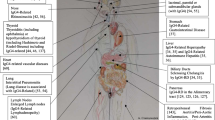Abstract
The World Health Organization (WHO) has revised the classification of hematolymphoid tumors (WHO-HAEM5) in August 2022 to incorporate certain recent changes in understanding of disease biology. This article highlights the important changes, with particular reference to those most relevant to children.
Similar content being viewed by others
References
WHO Classification of Tumours Editorial Board. Haematolymphoid tumors. WHO Classification of Tumours series, 5th edition, volume 11 [Internet; beta version ahead of print]. Lyon (France): International Agency for Research on Cancer; 2022 Accessed July 22, 2023. Available from: https://tumourclassification.iarc.who.int/chapters/63
International Agency for Research on Cancer. WHO Classification of Tumours of Haematopoietic and Lymphoid Tissues. WHO Classification of Tumours, Revised 4th Edition, Volume 2 [Internet]. Accessed on July 22, 2023. Available from: https://publications.iarc.fr/Book-And-Report-Series/Who-Classfication-Of-Tumours/WHO-Classification-Of-Tumours-Of-Haematopoietic-And-Lymphoid-Tissues-2017
Alaggio R, Amador C, Anagnostopoulos I, et al. The 5th edition of the World Health Organization Classification of haematolymphoid tumours: lymphoid neoplasms. Leukemia. 2022;36:1720–48.
Thol F. ALL is not the same in the era of genetics. Blood. 2021;138:915–6.
Eichenauer DA, Engert A. Nodular lymphocytepredominant Hodgkin lymphoma: a unique disease deserving unique management. Hematology Am Soc Hematol Educ Program. 2017;2017:324–8.
Chabay PA, Preciado MV. EBV primary infection in childhood and its relation to B-cell lymphoma development: A mini-review from a developing region. Int J Cancer. 2013;133:1286–92.
Khoury JD, Solary E, Abla O, et al. The 5th edition of the World Health Organization Classification of haemato lymphoid tumours: myeloid and histiocytic/dendritic neoplasms. Leukemia. 2022;36:1703–19.
de Vries ACH, Zwaan CM, van den Heuvel-Eibrink MM. Molecular basis of juvenile myelomonocytic leukemia. Haematologica. 2010;95:179–82.
Patel SS. Pediatric Myelodysplastic Syndromes. Clin Lab Med. 2021;41:517–28.
Hernández-Rivas JM. Secondary myeloid neoplasias: an emerging group of diseases. Rev Bras Hematol Hemoter. 2011;33:403–4.
Alexander TB, Gu Z, Iacobucci I, et al. The genetic basis and cell of origin of mixed phenotype acute leukaemia. Nature. 2018;562:373–9.
Funding
Funding: None
Author information
Authors and Affiliations
Contributions
Contributors: DM, RS: Conceptualized the manuscript. DM, RS, SM: Wrote the manuscript. RS: Supervised the work. All authors approved the final manuscript.
Corresponding author
Ethics declarations
Competing interests: None stated.
Rights and permissions
About this article
Cite this article
Mohapatra, D., Seth, R. & Mallick, S. The 5th Edition of the World Health Organization (WHO) Classification of Hematolymphoid Tumors: What’s New in Pediatrics?. Indian Pediatr 61, 69–74 (2024). https://doi.org/10.1007/s13312-024-3093-4
Published:
Issue Date:
DOI: https://doi.org/10.1007/s13312-024-3093-4




